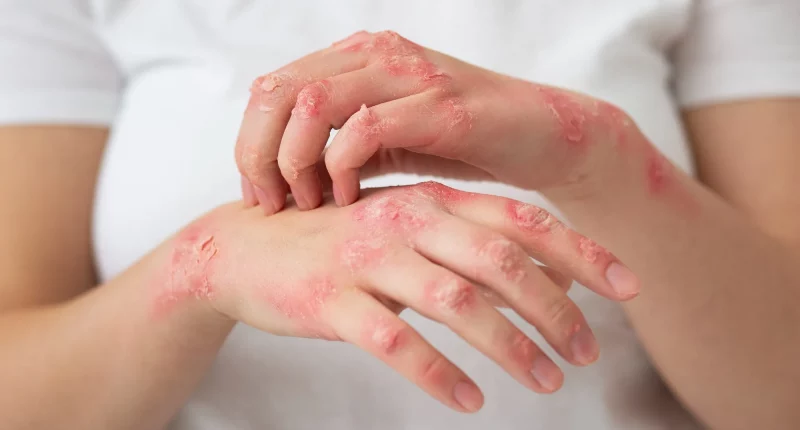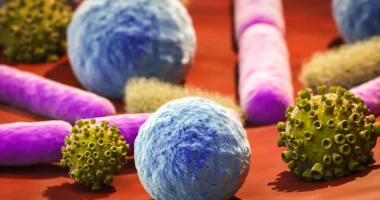Bowen’s disease is a skin problem where red, scaly patches develop on the skin because of changes in skin cells on the outer layers of the skin. Doctors think these patches are the earliest stage of a type of skin cancer called squamous cell carcinoma, as per the American Cancer Society.
Bowen’s disease looks a lot like actinic keratosis, another skin condition that can turn into cancer. The important difference is that Bowen’s disease patches are usually bigger than senile keratosis patches.
Besides showing up on parts of the skin that are easy to see, Bowen’s disease patches may also show on the genitals and anus. Healthcare providers call Bowen’s disease in these areas Erythroplasia of Queyrat or bowenoid papulosis.
Symptoms
Bowen’s disease typically causes slow-growing skin wounds, which can appear as dry, scaly plaques or red-brown patches. These patches can also ooze pus, bleed, itch, or be sensitive to the touch. It can sometimes resemble other skin conditions such as fungal infections, psoriasis, eczema, or particular rashes.
While many individuals with Bowen’s disease may only have one lesion, about 10–20% develop numerous lesions on different parts of their body. It’s important to note that some of these lesions can progress to become cancerous. Therefore, individuals with Bowen’s disease should be vigilant for signs that a skin wound might be turning cancerous, such as hardening, tenderness, the appearance of a flesh-colored (pink or red) lump or nodule, or easy bleeding.
If any of these changes are noticed on the skin, it is crucial to seek prompt evaluation by a dermatologist. Early detection and treatment can significantly improve outcomes.
Causes
Doctors haven’t pinpointed the actual cause of Bowen’s disease, but they’ve identified several risk factors associated with the condition. These include aging, chronic exposure to arsenic, prolonged contact with sun, fair skin that’s frequently exposed to sunlight, and a history of certain types of human papillomavirus (HPV). Additionally, individuals with weak immune systems due to prolonged steroid use, HIV infection, or cancer are also at higher risk.
According to the National Organization for Rare Disorders, Bowen’s disease most commonly affects Caucasian individuals aged 60 years and older. Understanding these risk factors can help in both prevention and early detection of the condition, promoting better management and outcomes for affected individuals.
Treatment
Treatment for Bowen’s disease is tailored based on several factors including the place and appearance of lesions, as well as the individual’s age and overall health.
Each medication option carries its own set of risks and benefits, which should be carefully discussed with a healthcare provider. Treatment alternatively commonly includes:
Cryotherapy involves adopting freezing substances like liquid nitrogen or argon gas to destroy affected skin cells. Curettage is a surgical procedure where the lesion is burned and scraped away using specialized tools. Photodynamic therapy uses a special medicine that reacts to light exposure to destroy abnormal skin cells.
Surgical removal may be recommended, where the lesion is excised and the incision is closed. For lesions in sensitive areas like the head, neck, or fingernails, Mohs micrographic surgery is a precise technique that preserves surrounding healthy tissue. Topical chemotherapy, such as 5-fluorouracil or imiquimod 5%, can also be applied directly to the lesion.
Not all Bowen’s disease lesions require immediate treatment, especially if they are slow-growing. In some cases, especially if the individual has conditions like diabetes that could affect healing, healthcare providers may suggest a watch-and-wait approach to monitor lesion progression before deciding on treatment.
Prevention
Preventing Bowen’s disease largely revolves around minimizing sun exposure, which is a major risk factor for the condition. Simple steps can significantly reduce the likelihood of developing it:
Avoiding tanning beds, which expose the skin to harmful ultraviolet light, is crucial. Limiting outdoor work during peak sunlight hours and wearing protective clothes such as hats and long sleeves can also shield the skin. Regularly applying sunscreen with a high SPF (at least 30) and reapplying it often, especially after sweating or swimming, adds another layer of protection.
While reducing sun exposure can lower the risk of Bowen’s disease, it’s important to note that even individuals with minimal sun exposure history can still develop the condition. Therefore, maintaining these preventive measures is advisable for everyone, regardless of their sun exposure history.
Differentiating Bowen’s Disease from Other Forms of Skin Cancer
Bowen’s disease stands apart from other types of skin cancer due to its distinct characteristics and potential progression:
There are various types of skin cancer, each with its own unique features, like basal cell carcinoma, melanoma, and squamous cell carcinoma. Bowen’s disease, while considered an early form of squamous cell carcinoma, primarily affects the outer layers of the skin.
Unlike basal cell carcinoma, which develops in the deeper layers of the epidermis, squamous cell carcinoma—including Bowen’s disease—begins in the upper layers of the skin cells. Melanoma, on the other hand, originates from the pigmented part of skin cells known as melanin.
Understanding these differences is crucial for early detection and appropriate management of skin cancer. Each type of skin cancer requires specific approaches to diagnosis, treatment, and prevention, emphasizing the importance of regular skin checks and prompt medical attention for any concerning changes.
Outlook
Most skin lesions associated with Bowen’s disease grow slowly, which allows time for treatment before they might develop into cancer. Treatment options are diverse and often successful in managing the condition effectively. This combination of slow growth and effective treatments contributes to a favorable prognosis for most individuals with Bowen’s disease.
Summary
Bowen’s disease is a slow-growing skin condition that appears as red, scaly patches due to changes in skin cells, often linked to sun exposure and certain viruses. It can resemble other skin issues but is distinguishable by its progression potential into squamous cell carcinoma. Treatment options vary from freezing and surgical removal to topical therapies, tailored to lesion size and location. Prevention involves limiting sun exposure and using protective clothing and sunscreen. Prognosis is generally positive with early detection and treatment, ensuring most cases are managed effectively without progressing to cancer.
External links








